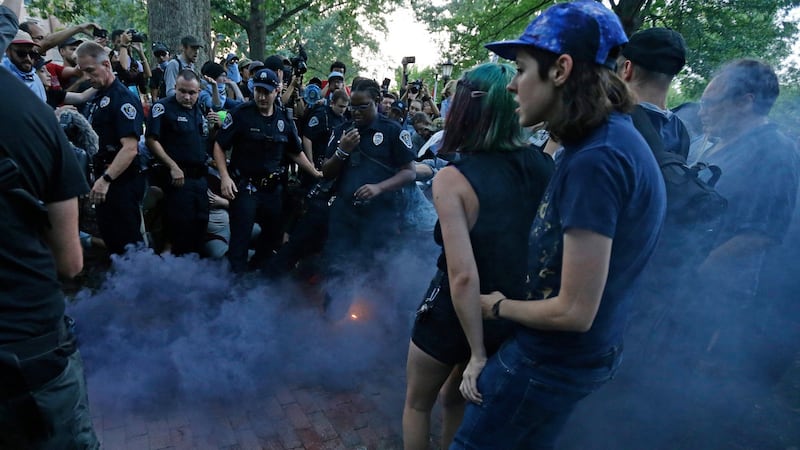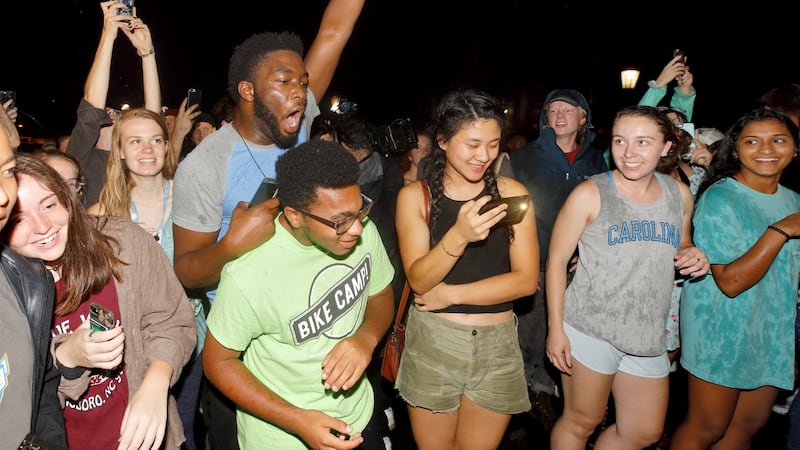Protesters toppled a statue of a Confederate soldier on the campus of University of North Carolina on Monday, the latest move to dismantle American Civil War symbols amid a fierce debate about race and the legacy of slavery in the United States.
The statue, erected in 1913 and known as Silent Sam, fell after nightfall on the campus, brought down by demonstrators who regarded it as an enduring tribute to white supremacy.
Many Americans see such statues as symbols of racism and glorifications of the southern states’ defence of slavery in the civil war, but others view them as important symbols of American history.

Although university officials had signalled their misgivings about the statue’s continued presence on their campus, they had argued that state law forbade them from moving the monument without a panel’s approval.
Critics of the statue celebrated its downing and tried to bury the soldier’s head in the North Carolina dirt. But the university, in a statement issued after the statue was brought down, said: “Tonight’s actions were dangerous, and we are very fortunate that no one was injured. We are investigating the vandalism and assessing the full extent of the damage.”
The university estimated that about 250 people were involved in Monday night’s demonstration. At least one person was arrested on charges of concealing one’s face during a public rally and resisting arrest, the university said. Before the statue was felled, demonstrators, who gathered to oppose possible sanctions against a student who splashed red ink and blood on the monument in April, marched across the campus and sometimes exchanged verbal barbs with counterprotesters.

Smoke bombs and chants
Eventually during the hours-long demonstration speckled with smoke bombs and chants, protesters erected coverings around the monument, shielding some of the statue’s critics while they worked to bring down the display that loomed above the campus.
Patty Matos, a 23-year-old senior who was at the protest while the statue still stood, said demonstrators had linked arms and formed concentric circles around the statue to protect those putting up banners.
One protester, she said, handed out bandannas with the words "Sam Must Fall" printed on them. Eventually, Silent Sam did fall. "It was all smiles and joy and dancing and jubilation, to be honest," said Jasmin Howard, a 28-year-old alumna who was present for the protest and standing in the back of the crowd when the statue was brought down. "It was really a joyous moment."
But the authorities beyond the university, even those who opposed the statue, reacted with conspicuous caution. Ford Porter, a spokesman for Governor Roy Cooper, said, "The governor understands that many people are frustrated by the pace of change and he shares their frustrations, but violent destruction of public property has no place in our communities."
Although Confederate monuments have long been a source of angst in the modern South of the United States, they have come under particular scrutiny since a white supremacist murdered nine black churchgoers in Charleston, South Carolina, in June 2015. The next month, South Carolina lawmakers removed a Confederate battle flag that flew outside the Capitol in Columbia, and other symbols of the Confederacy have since been removed or challenged.
The dramatic demonstration on Monday followed decades of controversy and protest at UNC that had accelerated in the last year, after the fatal eruption of racist violence in Charlottesville, Virginia. The university said last year that "removing the Confederate monument is in the best interest of the safety of our campus," but UNC officials also contended that a state law essentially foreclosed any immediate changes.
Precious blood
The statue has been a part of campus life in Chapel Hill for well over a century. The United Daughters of the Confederacy proposed the monument, which the university's board approved in June 1908. At the time of the statue's unveiling, in 1913, one speaker declared that "the whole Southland is sanctified by the precious blood of the student Confederate soldier" and boasted of how he had treated a "Negro wench" after his return from Appomattox. That speaker said the statue was raised to honour Confederate soldiers; decades later, its current name was first used.
And the university president at the time of its unveiling alluded to Robert E Lee, the Confederate general, when he hailed the monument as "an ornament to the campus" and as "a splendid lesson in granite and bronze to all coming generations of students throughout the years that in the words of the immortal Lee, 'Duty is the sublimest word in the English language.'"
But the protests of recent months had suggested that the statue might endure only so much longer. Matos, the senior, attended a demonstration last year but said the protest Monday night felt different. “I felt a little bit more fed up this time around,” she said. “Last year, it felt like something almost a little bit more routine.” On Monday, she said, “It felt a little bit more determined.” - New York Times, Reuters










